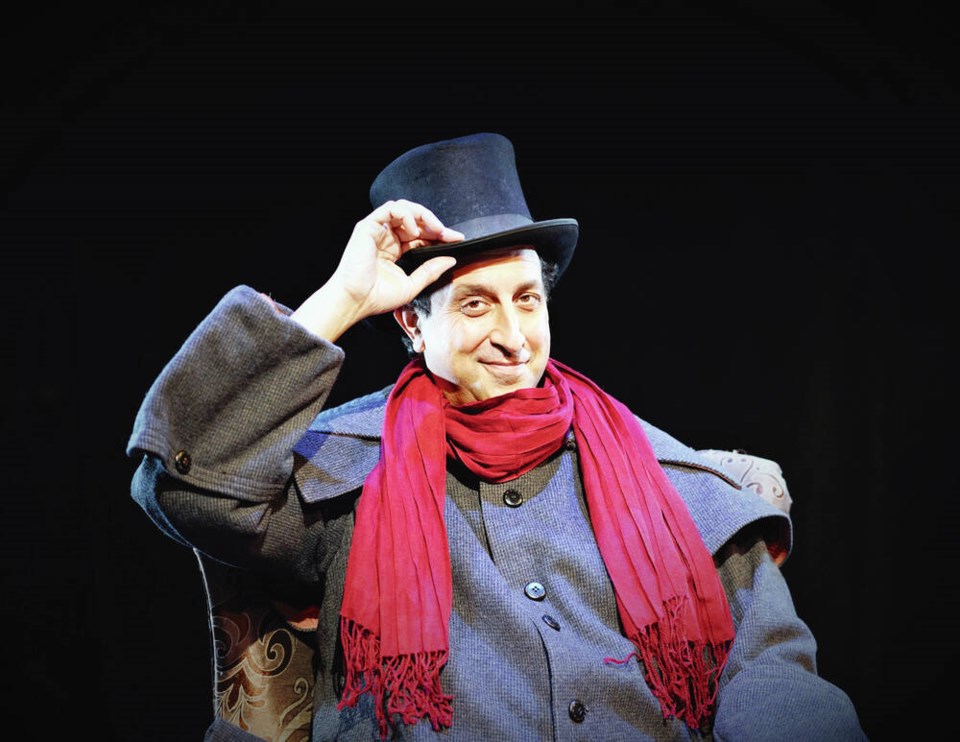There’s said to be more than 130 adaptations of A Christmas Carol, Charles Dickens’ cautionary novella about a miserly geezer who survives one heck of bad night.
The 1843 tale has been adapted for theatre, opera, movies and dance. The story’s so entrenched in Western culture, it’s led to such dubious cinematic homages as A Flintstones Christmas Carol, The Muppet Christmas Carol and Mister Magoo’s Christmas Carol (sample line: “Oh Magoo, you’ve done it again….!” )
Happily, Blue Bridge Repertory Theatre has opted for the traditional with its version, now playing the Roxy Theatre. A Christmas Carol is a one-man show starring Shaw Festival veteran Sanjay Talwar. In a monumental feat of memorization the actor delivers a two-hour monologue that stays true to the text and is a pure joy to witness.
On Wednesday night a masked audience gathered to see Talwar — top-hatted and waist-coated — strut his stuff for a preview performance.
It’s the second time he’s done it for Blue Bridge. Last year, in deference to the pandemic, it was exclusively livestreamed. This season the company offers both streamed and in-person performances (the latter is available only to the vaccinated).
Talwar delivers much more than a simple reading. He portrays all the characters, making each distinctive and memorable, nimbly navigating a number of accents. Aside from Ebenezer Scrooge we meet the ghosts of Christmas past, present and future, Bob Cratchit, Tiny Tim, Jacob Marley, Fezziwig and Scrooge’s nephew, Fred.
Under Jacob Richmond’s thoughtful direction, Talwar brings the text to life by acting everything out in a meticulous manner. There’s a sharp eye for even the smallest details. The mention of a “portly gentleman,” for example, prompts Talwar to put his hands over his stomach.
Alistair Sim, who starred in the celebrated 1951 film version of A Christmas Carol, created a Scrooge who was a bit frightening (thanks in part to his hollow eyes and picket-fence teeth). Talwar’s presence is more genial, much warmer. This serves to make the show accessible; he draws us in not only with his acting skills but his sheer likeability.
Designer Hans Saefkow has concocted a lovely set of a Victorian-era living room with a big fireplace, flanked by silhouettes of fancifully tilted houses. The show also benefits from subtle shifts in lighting, understated fog effects and low-key incidental music.
That’s all well and good. Yet at its core the show is a testament to the simple power of story-telling.
Most of us are familiar with the story. Scrooge is a cranky tightwad who scoffs at do-gooders soliciting alms for the poor . He bemoans giving his clerk a day off with pay at Christmas. Scrooge is visited by three spirits who convince him that, unless he sees the error of his ways, he’ll die alone and friendless.
Experiencing the text first-hand reveals things that may surprise those who’ve never read it. For instance, Dickens (said to be an enthusiastic foodie) includes descriptions of Christmas feasts almost erotic in their rapturousness.
Take this: “Heaped up on the floor, to form a kind of throne, were turkeys, geese, game, poultry, brawn, great joints of meat, sucking-pigs, long wreaths of sausages, mince-pies, plum-puddings, barrels of oysters, red-hot chestnuts, cherry-cheeked apples, juicy oranges, luscious pears, immense twelfth-cakes, and seething bowls of punch, that made the chamber dim with their delicious steam.”
The description is not only hunger inducing, it’s dense. Imagine how difficult the task of memorization must be.
Later on the creation of a Christmas pudding is narrated with the breathless enthusiasm of an NFL announcer. Here Talwar, aware the Dickens is having a bit of fun with us, shifts to a jocular tone.
The writing is a delight throughout. Describing Marley’s ghostly face appearing on a door knocker, we’re offered this surreal simile: “it had a dismal light about it, like a bad lobster in a dark cellar”.
At the end a repentant Scrooge buys a jumbo turkey for his nephew and begins laughing in a manner as maniacal as it is joyful. It is, above all, the laughter of relief. And we the audience chuckle along too, having taken a journey both wild and wonderful.
A Christmas Carol continues at the Roxy Theatre to Dec. 19.

